 W
WProject 112 was a biological and chemical weapon experimentation project conducted by the United States Department of Defense from 1962 to 1973.
 W
WFleet Band Activities (FBA), formerly the Navy Music Program (NMP), is the central management office for nine active-duty fleet bands of the United States Navy. It is located at Naval Support Activity Mid-South in Millington, Tennessee. FBA has the responsibility of coordinating the assignment and distribution of personnel, equipment and funding to the worldwide activities of navy military bands. It also is responsible for managing the application and audition process for potential navy musicians. Personnel from the FBA work directly with the Bureau of Naval Personnel to meet our musician requirements for the fleet.
 W
WFracture Jaw was a top-secret U.S. military contingency plan in which General William C. Westmoreland sought to ensure that nuclear weapons would be available for use in the Vietnam War. The plan included moving nuclear weapons into South Vietnam so that they could be used on short notice against North Vietnamese troops. In spite of moves towards activating the plan, the project was abandoned in February 1968 when it was discovered by the White House.
 W
WProject Gemini was NASA's second human spaceflight program. Conducted between projects Mercury and Apollo, Gemini started in 1961 and concluded in 1966. The Gemini spacecraft carried a two-astronaut crew. Ten Gemini crews and sixteen individual astronauts flew low Earth orbit (LEO) missions during 1965 and 1966.
 W
WGlomb, from "glide bomb", was a project undertaken by the United States Navy during World War II to develop an unmanned aircraft for delivering bombs to high-value, well-protected targets without risk to aircrew. The project proceeded through the war, producing several prototype aircraft, but technical limitations meant no Glombs saw operational service and the program was cancelled at the end of the war.
 W
WProject Highwater was an experiment carried out as part of two of the test flights of NASA's Saturn I launch vehicle, successfully launched into a sub-orbital trajectory from Cape Canaveral, Florida. The Highwater experiment sought to determine the effect of a large volume of water suddenly released into the ionosphere. The project answered questions about the effect of the diffusion of propellants in the event that a rocket was destroyed at high altitude.
 W
WProject Magnet was a major geomagnetic survey effort from 1951 through 1994. The project originated in the U.S. Navy Hydrographic Office, renamed the U.S. Naval Oceanographic Office (NAVOCEANO), supporting world magnetic modeling and charting. The project used aircraft flying magnetic surveys worldwide. Additional magnetic data were collected with geophysical survey ships in conjunction with other projects for combination into final products. Data was used to support navigation of ships and aircraft and to meet Naval requirements as well as scientific research.
 W
WMKNAOMI was the code name for a joint Department of Defense/CIA research program lasting from the 1950s through the 1970s. Unclassified information about the MKNAOMI program and the related Special Operations Division is scarce. It is generally reported to be a successor to the MKULTRA project and to have focused on biological projects including biological warfare agents—specifically, to store materials that could either incapacitate or kill a test subject and to develop devices for the diffusion of such materials.
 W
WOperation Bumblebee was a US Navy effort to develop surface to air missiles (SAMs) to provide a mid-range layer of anti-aircraft defence, between anti-aircraft guns in the short range and fighter aircraft operating at long range. A major reason for the Bumblebee efforts was the need to attack bombers before they could launch standoff anti-shipping weapons, as these aircraft might never enter the range of the shipboard guns.
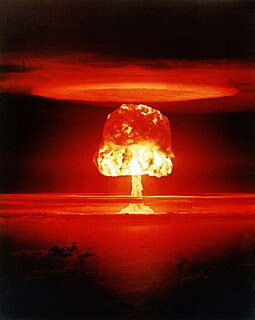 W
WOperation Castle was a United States series of high-yield (high-energy) nuclear tests by Joint Task Force 7 (JTF-7) at Bikini Atoll beginning in March 1954. It followed Operation Upshot–Knothole and preceded Operation Teapot.
 W
WOperation CHASE was a United States Department of Defense program for the disposal of unwanted munitions at sea from May 1964 until the early 1970s. Munitions were loaded onto ships to be scuttled once they were at least 250 miles offshore. While most of the sinkings involved conventional weapons, four of them involved chemical weapons. The disposal site for the chemical weapons was a three-mile (5 km) area of the Atlantic Ocean between the coast of the U.S. state of Florida and the Bahamas. The CHASE program was preceded by the United States Army disposal of 8000 tons of mustard and lewisite chemical warfare gas aboard the scuttled SS William C. Ralston in April 1958. These ships were sunk by having Explosive Ordnance Demolition (EOD) teams open seacocks on the ship after they arrived at the disposal site. The typical Liberty ship sank about three hours after the seacocks were opened.
 W
WOperation Crossroads was a pair of nuclear weapon tests conducted by the United States at Bikini Atoll in mid-1946. They were the first nuclear weapon tests since Trinity in July 1945, and the first detonations of nuclear devices since the atomic bombing of Nagasaki on August 9, 1945. The purpose of the tests was to investigate the effect of nuclear weapons on warships.
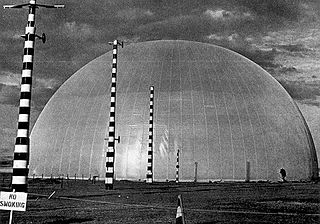 W
WOperation Distant Plain was a series of non-nuclear explosive and detonable gas tests performed on test sites in Alberta, Canada during the course of 1966 and 1967. Their purpose was to provide airblast, cratering and ground shock data in summer and winter conditions for testing new prototype equipment, military targets and coniferous forest blowdown and defoliation. Participants included Canada, United Kingdom, Australia and United States under the Tripartite Technical Cooperation Program. Detonable gas balloons were used in this operation in an attempt to find an economical substitute for TNT as well as for the fact that they could be placed at desired heights without a heavy support structure or towers. In addition, they were more adaptable to airblast phenomena and produced a well defined blast wave without perturbation or ejecta; they also produced no crater. However, it was found that they lacked the high pressure associated with high explosives, and difficulties were encountered as the 20-ton gas balloon ruptured and another detonated unexpectedly during inflation. Ultimately ANFO was elected as a lower cost alternative to TNT for non-nuclear explosives tests.
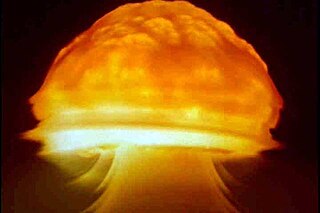 W
WOperation Dominic was a series of 31 nuclear test explosions with a 38.1 Mt (159 PJ) total yield conducted in 1962 by the United States in the Pacific. This test series was scheduled quickly, in order to respond in kind to the Soviet resumption of testing after the tacit 1958–1961 test moratorium. Most of these shots were conducted with free-fall bombs dropped from B-52 bomber aircraft. Twenty of these shots were to test new weapons designs; six to test weapons effects; and several shots to confirm the reliability of existing weapons. The Thor missile was also used to lift warheads into near-space to conduct high-altitude nuclear explosion tests; these shots were collectively called Operation Fishbowl.
 W
WOperation Prairie Flat was a test involving the detonation of a 500-short-ton (450 t) spherical surface charge of TNT to evaluate airblast, ground shock and thermal effects of nuclear weapons. Since TNT charges produce roughly double the airburst effect of nuclear weapons, it allowed testing the equivalent of a 1 kiloton of TNT (4.2 TJ) nuclear weapon surface burst. It was a continuation of the technical co-operation series of tests sponsored jointly by the respective governments. Similar to previous tests, a large number of projects were carried out simultaneously due to the infrequent opportunity and cost of large explosives tests – the United States alone conducted 39 projects. The resulting airblast also allowed testing various targets at a range of overpressures to verify how structures resist effects of nuclear weapons. These included troop field shelters, fiberglass manholes, foxhole overhead covers, blast valves and electrical generators. Debris fracturing and transport were also tested as part of the effort to understand nuclear blast effects on Nike-X anti-ballistic missile sites. An additional goal of the test was to compare the blast with the previous Distant Plain Event 6 that used an equivalent but smaller 100-short-ton (91 t) configuration in order to study scaling factors.
 W
WOperation Sailor Hat was a series of explosives effects tests, conducted by the United States Navy Bureau of Ships under the sponsorship of the Defense Atomic Support Agency. The tests consisted of two underwater explosions at San Clemente Island, California in 1964 and three surface explosions at Kahoʻolawe, Hawaii in 1965. They were non-nuclear tests employing large quantities of conventional explosives to determine the effects of a nuclear weapon blast on naval vessels, and the first major test of this kind since Operation Crossroads in July 1946.
 W
WOperation Snowball was a conventional explosive test to obtain information on nuclear weapon detonations run by the Defence Research Board with participation from the United Kingdom and United States. A detonation of 500 short tons (454 t) of TNT was used to study the resulting phenomena. The test was held at the Suffield Experimental Station in Alberta and was the largest ever man-made, non-accidental explosion in Canada. The test was also the first of its kind using a stacked TNT block hemisphere of such magnitude, a method repeated in six subsequent tests such as Operation Sailor Hat and Prairie Flat. The test allowed verifying predicted properties of shock and blast and determining its effect on a variety of military targets at varied distances from ground zero.
 W
WProject A119, also known as A Study of Lunar Research Flights, was a top-secret plan developed in 1958 by the United States Air Force. The aim of the project was to detonate a nuclear bomb on the Moon, which would help in answering some of the mysteries in planetary astronomy and astrogeology. If the explosive device detonated on the surface, not in a lunar crater, the flash of explosive light would have been faintly visible to people on Earth with their naked eye, a show of force resulting in a possible boosting of domestic morale in the capabilities of the United States, a boost that was needed after the Soviet Union took an early lead in the Space Race and was also working on a similar project.
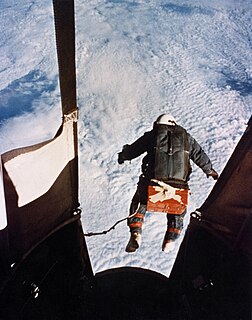 W
WProject Excelsior was a series of parachute jumps made by Joseph Kittinger of the United States Air Force in 1959 and 1960 from helium balloons in the stratosphere. The purpose was to test the Beaupre multi-stage parachute system intended to be used by pilots ejecting from high altitude. In one of these jumps Kittinger set world records for the longest parachute drogue fall, the highest parachute jump, and the fastest speed by a human through the atmosphere. He held the latter two of these records for 52 years, until they were broken by Felix Baumgartner of the Red Bull Stratos project in 2012, though he still holds the world record for longest time in free fall.
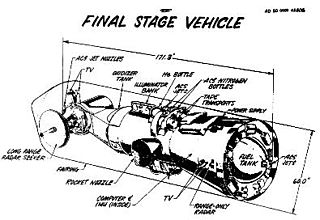 W
WProject SAINT was a project undertaken by the United States during the Cold War to develop a means of intercepting, inspecting and destroying Soviet spacecraft. Many details relating to the project are still classified. The order to launch the SAINT could only be given by the NORAD commander-in-chief, and presumably, anyone higher ranked than them. Developed during the late 1950s and early 1960s, the project was heavily over budget by the time it was cancelled in late 1962. As a result of advances in countermeasures on Soviet satellites, alongside the development of cheaper anti-satellite methods, the concept was rendered unsuitable.
 W
WProject West Ford was a test carried out by Massachusetts Institute of Technology's Lincoln Laboratory on behalf of the United States Military in 1961 and 1963 to create an artificial ionosphere above the Earth. This was done to solve a major weakness that had been identified in US military communications.
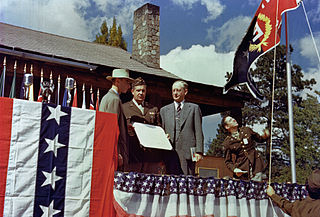 W
WThe Los Alamos Laboratory, also known as Project Y, was a secret laboratory established by the Manhattan Project and operated by the University of California during World War II. Its mission was to design and build the first atomic bombs. Robert Oppenheimer was its first director, serving from 1943 to December 1945, when he was succeeded by Norris Bradbury. In order to enable scientists to freely discuss their work while preserving security, the laboratory was located in a remote part of New Mexico. The wartime laboratory occupied buildings that had once been part of the Los Alamos Ranch School.
 W
WA proximity fuze is a fuze that detonates an explosive device automatically when the distance to the target becomes smaller than a predetermined value. Proximity fuzes are designed for targets such as planes, missiles, ships at sea, and ground forces. They provide a more sophisticated trigger mechanism than the common contact fuze or timed fuze. It is estimated that it increases the lethality by 5 to 10 times, compared to these other fuzes.
 W
WProject Stormfury was an attempt to weaken tropical cyclones by flying aircraft into them and seeding with silver iodide. The project was run by the United States Government from 1962 to 1983. The hypothesis was that the silver iodide would cause supercooled water in the storm to freeze, disrupting the inner structure of the hurricane, and this led to seeding several Atlantic hurricanes. However, it was later shown that this hypothesis was incorrect. It was determined that most hurricanes do not contain enough supercooled water for cloud seeding to be effective. Additionally, researchers found that unseeded hurricanes often undergo the same structural changes that were expected from seeded hurricanes. This finding called Stormfury's successes into question, as the changes reported now had a natural explanation.